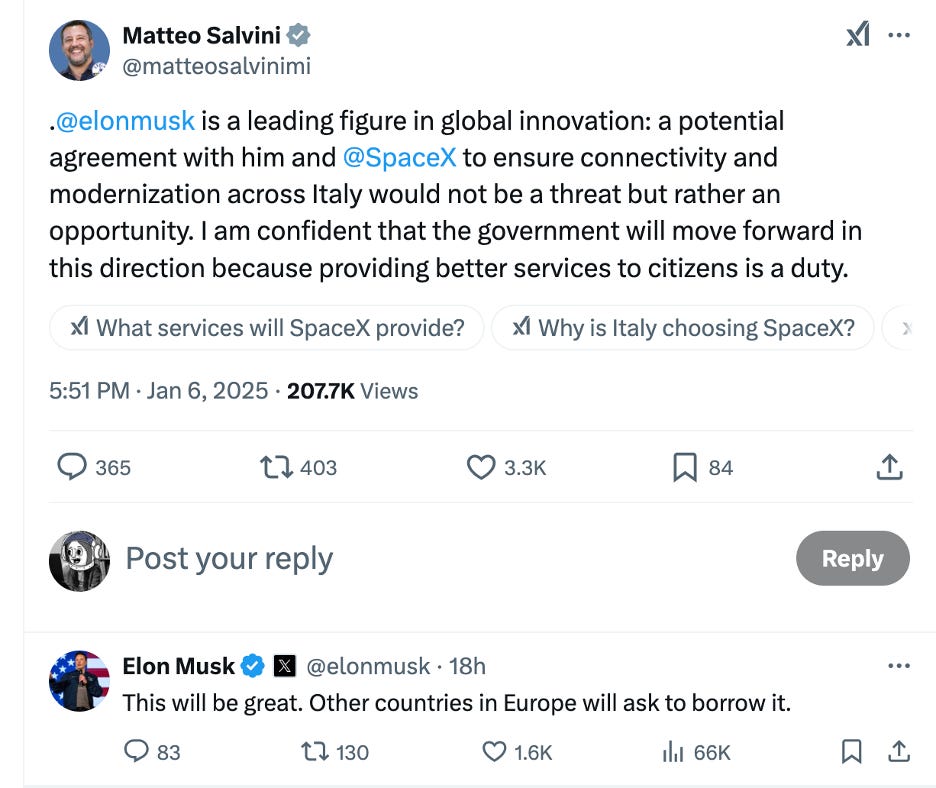Italy and its Starlink's strategy
Can a country outsourcing its communications still claim to be sovereign?

The news that Italy might purchase €1.5 billion worth of Starlink services to provide secure connectivity for governmental operations has sent ripples through the European space community. Europe, after all, has spent the past few years struggling to push its own secure connectivity initiatives, such as IRIS2, across the finish line. While Italy’s move is likely motivated by the need for a reliable backup during natural disasters, it raises broader questions: Why haven’t Italy—or Europe as a whole—invested in secure connectivity earlier? And what does it mean for a nation to depend on foreign infrastructure for something as crucial as national security? If sovereignty hinges on self-reliance, can a country outsourcing its communications still claim to be sovereign?
Talks Confirmed but No Contracts Yet
On January 5, Bloomberg reported that Italy was advancing discussions with Elon Musk’s SpaceX on a €1.5 billion deal to secure satellite telecommunications for government use. Musk seemingly confirmed the report on X, proclaiming, “Ready to provide Italy the most secure and advanced connectivity!” Yet, Palazzo Chigi swiftly issued a clarification, denying any contracts or agreements had been signed. In its statement, the government acknowledged ongoing talks with SpaceX, framing them as “normal consultations” between state institutions and companies providing encrypted data communication services. ASI (the Italian Space Agency) echoed Palazzo Chigi’s official statement in a recent interview with SpaceWatch.Global.
The Debate Over Sovereignty
The prospect of Italy—a sovereign European nation—relying on Starlink rather than IRIS² (a European initiative funded in part by Italy) or existing options like Govsatcom has sparked intense debate in the European space community.
Under Article 25 of the recently presented Italian National Space Law, the government has prioritized establishing a "reserve of national transmission capacity"—a satellite-based backup system for strategic communications in emergencies. The law specifies that such services must be allocated exclusively to European or NATO entities. If this is indeed the rationale behind Italy’s interest in Starlink, it underscores the urgency of having a reliable contingency plan for natural disasters, which Italy is particularly prone to. However, €1.5 billion for a temporary emergency arrangement seems excessive—that’s more of the entire annual budget of the Italian space sector.
It’s hard to ignore the deeper implications of this choice. Why should a European nation rely on an American private company for such critical infrastructure?
Cost vs. Sovereignty
Bloomberg reported that the Italian government considered alternatives like IRIS² or building its own satellite constellation. However, these options came with prohibitive costs—exceeding €10 billion. In contrast, Starlink presented a far more affordable, already operational solution. Moreover, Starlink is advancing with its next-generation “V3” satellites, expected to be deployed via upcoming Starship and Falcon 9 launches. Each V3 satellite will deliver impressive capabilities, boasting a 1 Tbps downlink speed and up to 160 Gbps uplink capacity—offering more than a tenfold improvement in downlink performance and roughly 24 times the uplink capacity of its predecessors.
Still, the comparison between Starlink and IRIS² is fundamentally flawed. Starlink is a mega-constellation built by a U.S. private company, designed to serve American civil and military interests while generating revenue. Starlink may be available globally, but it is by no means a neutral platform.
If even the U.S. government approaches SpaceX with caution, it is troubling to imagine other nations placing blind trust in the same company for their most critical infrastructure.
Opting for the cheapest solution in matters of national security reflects a market-driven mindset that overlooks the strategic stakes. Starlink is controlled by Elon Musk, a figure whose political leanings and decisions have often been polarizing and volatiles (He recently pledged to offer Nigel Farage’s far-right party, Reform UK, $100,000, only to call for his replacement a few days later). Relying on a private entity with such volatility poses significant risks. Musk’s behavior during the early months of the Ukraine conflict serves as a cautionary tale: while initially providing Starlink services, he unilaterally imposed limitations on Ukrainian military operations and temporarily halted services until the Pentagon intervened with a proper contract. This episode highlights the fragility of depending on a private actor for national security.

The United States is well aware of these risks when it comes to its own security. As reported by Military.com in November 2024, Senators Jack Reed (D-R.I.), chairman of the U.S. Senate Armed Services Committee, and Jeanne Shaheen (D-N.H.), a senior member of the Armed Services and Foreign Relations committees, called for an investigation into Musk's interactions with the Kremlin. They questioned whether his actions should prompt a review of SpaceX's involvement with the Department of Defense.
If even the U.S. government approaches SpaceX with caution, it is troubling to imagine other nations placing blind trust in the same company for their most critical infrastructure.
Can Italy Build Its Own Network?
Starlink’s current fleet of 7,000 satellites is set to double over the next decade, primarily serving U.S. strategic objectives. The sheer volume of satellites in low Earth orbit (LEO) enables unparalleled 24/7 coverage, low latency, and the ability to transmit terabytes of data—far ahead of the capabilities of geostationary (GEO) systems. By contrast, GEO satellites operate at an altitude of 36,000 kilometers, resulting in higher latency, fixed coverage, and limited data transmission capacity.
Italy already operates its own secure and autonomous communication satellites for military and civil protection needs in geosynchronous orbit. This capability is provided by the SICRAL system (Sistema Italiano per Comunicazioni Riservate ed Allarmi), which originally included three geostationary satellites: SICRAL-1, SICRAL-1B, and SICRAL-2. However, the first two have reached the end of their operational life and have been decommissioned, moved to a GEO graveyard orbit. The only active satellite, SICRAL-2, will be joined by the more advanced SICRAL-3, expected to launch by 2026. This addition will restore a minimum of two operational satellites dedicated to government, military, and civil protection purposes. Italy also benefits from its collaboration with France through the Athena-Fidus satellite (Access on Theatres and European Nations for Allied Forces – French Italian Dual Use Satellite). This joint effort highlights the potential for meaningful European cooperation in building a common defense infrastructure.
Ultimately, this is a question of strategy. If Italy determines—and it appears it has—that Tbps-level downlink speeds are critical, a LEO-based solution is the most viable path. Why not consider building its own constellation of secure satellites then? Such a project, while ambitious, could become feasible if the €1.5 billion earmarked for Starlink were redirected toward developing a national LEO mini-constellation tailored to meet all governmental needs: military, defense, security, civil protection, and natural disaster management.
When paired with IRIDE, Italy’s upcoming €1.1 billion Earth observation constellation of 69 satellites, this could significantly bolster Italy’s position in the space sector. It would reaffirm its role as the third-largest contributor to ESA and a leading player in NATO, proving that an ambitious but strategically sound investment could transform Italy into a space power in its own right.
A Broader European Failure
This situation highlights a gap in Europe’s space strategy: a failure to invest in secure, sovereign connectivity over the past two decades. While Govsatcom will come online next year and IRIS² is slated for completion in a decade, these initiatives are playing catch-up to Starlink. Most European nations have never seriously prioritized military satellite networks. Investments have instead gone toward other sectors, leaving Europe vulnerable in an era where secure communication is critical for sovereignty.
Regardless of Italy’s ultimate decision—likely influenced by political considerations beyond space policy—it serves as a stark reminder of Europe’s past neglect. This is not just an Italian problem; it’s emblematic of a broader European shortfall that will have repercussions for years to come.
Join the Debate
The debate has sparked widespread discussion among space experts, enthusiasts, and the general press. For further insights, here’s a selection of recent commentary:
Il Foglio: “Cosa Non Torna Nella Triangolazione sullo Spazio Tra Starlink e L’Italia” (Italian only)
Christophe Grudler’s LinkedIn post ( Christophe Grudler MEP ) and subsequent response by H. Ludwig Moeller (H. Ludwig Moeller )
La Repubblica: “SpaceX – Colao: ‘Rischiamo di Finire nelle Mani di un Monopolista. La Ue si Svegli, Siamo in Ritardo’” (Italian only)
If you have additional articles or insights, please share them in the comments.





